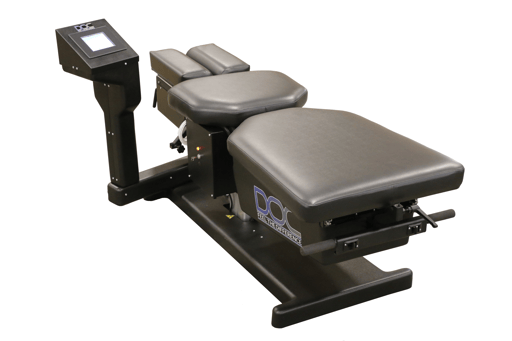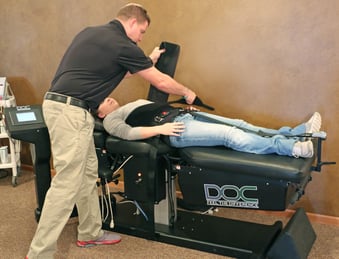How effective is spinal decompression? Patients continue to report a number of positive results related to back and neck pain related to pressure in the discs and vertebrae of the spine. Spine-Health.com recently interviewed two chiropractors—one from the East coast and one on the West coast—to share their real-world experiences of what to expect from this treatment.
Non-surgical spinal decompression is a treatment that uses a pulling force on the spine to relieve pressure on the discs and vertebrae in either the lumbar or cervical spine regions. It is used to treat a variety of common causes of back or neck pain, such as a herniated lumbar disc, bulging disc, spinal stenosis, degenerated disc, facet syndrome, or sciatica/leg pain. Spinal decompression can be delivered with the hands or by devices that essentially pull to separate the lower body from the upper body.
The concept of spinal decompression has been around for a number of years, but some feel that it still lacks enough clinical evidence to support the effectiveness claims of the treatment. Others say that the positive results of many patients speak for themselves. To shed some light on this topic through real-world experience, we interviewed two chiropractors from opposite ends of the United States, Dr. Eben Davis in San Francisco and Dr. Steven Shoshany in New York City, who have used spinal decompression in their practices for several years. We asked them about theirexperiences with spinal decompression in this exclusive Spine-health interview.
 |
Question: How long have you used spinal decompression in your practice? What percent of your patients receive spinal decompression treatment?
Dr. Shoshany: I made the decision to add spinal decompression to my practice seven years ago when it was still very new. I became interested in spinal decompression because my father had a really bad disc herniation issue that caused him terrible sciatica. He was helped by a chiropractor. I was sold and added this tool into my practice. Currently, spinal decompression makes up 30 percent of our practice.
Dr. Davis: We started using spinal decompression around 2005. At that time, I was the first individual in the San Francisco area to offer spinal decompression. Today there are at least 10 machines in the city. Out of my total business, about 5 percent of my patients have spinal decompression as part of their treatment plan.
Question: When do you use spinal decompression? When do you not use it?
Dr. Shoshany: We use spinal decompression mostly for patients that tried chiropractic care, physical therapy, had epidurals, and previous back surgeries with little results. We also consider spinal decompression when a patient presents us with a recent MRI that confirms herniated discs causing nerve pressure. It works particularly well for patients that suffer with chronic back pain, sciatica and spinal stenosis. The patient age range varies widely from 20-90 years of age. We do not use spinal decompression when a patient is either pregnant or has a metal implantation in their spine.
Dr. Davis: A good patient age range is between 25 and 55. It is important to manage expectations, as results may not be as immediate as one expects. This is especially true when performing spinal decompression on elderly patients.
Question: What results do you typically see from spinal decompression treatment? How do you measure the results?
Dr. Shoshany: Results vary depending on the severity of the condition. Obviously, the patient is looking for both a reduction of pain and the ability to return to their daily life and activities. We usually have patients feeling better by visit number five or six. Patients usually have complete relief from their symptoms when they are on the table being decompressed. There have been patients that did not notice any improvement until after we completed the protocol.
When a patient has an MRI, one objective finding is to do a comparative study to see if there has been any reduction in the size of the disc herniation.
Dr. Davis: Each individual may have different results. Some notice a difference within their first five to six treatments and others will find improvements after 20 visits.
Question: What other treatments do you typically combine with spinal decompression?
Dr. Shoshany: We like to combine spinal decompression with an effective core-strengthening program.
Dr. Davis: Sometimes we will include manual therapies, such as soft tissue techniques. A newer treatment that can be combined is deep tissue laser. The deep tissue laser is used to reduce inflammation and help with herniated discs.

Question: What is a typical spinal decompression treatment time frame?
Dr. Shoshany: The typical program calls for 20 visits over a course of six weeks, three to four times a week.
Dr. Davis: It depends on the patient’s complexity and extent of the rehabilitation needed. Typically, a patient is treated between 12 and 20 times. During this time, it is important to continually evaluate the treatment and adjust the treatment protocol as needed.
Question: What are the pros and cons of spinal decompression for patients and for chiropractors? What advice do you have for other chiropractors considering getting into spinal decompression now?
Dr. Shoshany: The pros of spinal decompression for the patient are that it is a non-surgical and non-drug approach. In addition, spinal decompression is extremely safe with little chance of hurting a patient. In fact, most patients fall asleep during spinal decompression treatments. Spinal decompression addresses the underlying structural issue that is causing a patient’s pain and dysfunction and is the most direct way to treat a problem. A con may be that treatment is out of the price range for some insurance plans and they will not pick up the cost of treatment.
My advice to any chiropractor getting started with spinal decompression is to invest in a solid table as opposed to cheaper models that claim to do everything. Today there are many tables in the market that claim to do spinal decompression. Do your homework and talk to doctors that are
 via PHSChiropractic.com via PHSChiropractic.com |
Dr. Davis: The main cons to consider are costs of the initial machine, the ongoing maintenance that is needed to keep it in running condition and the required insurance. The machine also takes up room. In addition, it can take time to educate a patient on spinal decompression, which increases the amount of time one spends in a consultation.
Before you incorporate spinal decompression, do a cost analysis. Don't assume others are making money. It's a competitive market and it takes time to get results. You may not get great results initially. Clinics and demographics of your area may also play a role. For example, pro athletes and golfers may already have spinal decompression in their sports clinic.
Question: What are good alternatives to spinal decompression if a patient doesn't want it or can’t afford it?
Dr. Shoshany: A good alternative might be inversion therapy at home if a patient can get into that position.
Dr. Davis: An alternative that may benefit patients looking for spinal decompression at home might be the use of an inversion table.
Download the Benefits of Spinal Decompression Therapy eBook!


